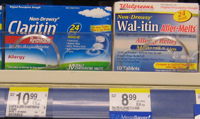Imitation is supposed to be the sincerest form of flattery. In the marketplace, it is also a deadly form of competition. Walk in any Walgreens store, you will see next to the name brands Walgreens’s store brands at a price discount ranging from 30% to 56%. There is no mistaking that the store brands are aimed directly at the name brands. The stickers invite the customers to compare the store brands with the relevant name brands. Even the names of the store brands echo the name brands. So Wal-itin rhymes with Claritin, Wal-phed with Sudafed, Wal-dryl with Benadryl, etc. And the labels of the store brands list the same active ingredients as the name brands. The similarity is so obvious that some store brand labels contain disclaimers that the store brands are not manufactured by the name brands.

Walgreens is not the only chain store engaging in such shadow branding. Another notable example is Wal-Mart’s Equate store brands. And grocery store chains have been pioneers in shadow branding.
The competitive advantage of shadow branding is very obvious. The name brands spend heavily on building brand recognition while the store brands get an almost free ride on the name brands. The name brands also must spend heavily on R&D to come up with new products while the store brands simply copy their ideas once the new products are established. With the sales data of the name brands from their cash registers, the chain stores can set the price points of store brands precisely for maximum competitive advantage. And since the chain stores also own the shelf space and can multiply store brands at will, the name brands that must compete with the stores for the limited shelf space are like sitting ducks waiting to be picked off by the shadow brands. During the past decade, store brands have risen from 15% of total grocery sales to 20%. The market share of Wal-Mart’s store brands is forecast to jump from 20% to 25% in the next five years (BW).
As counter moves, name-brand companies are trimming their product lines to concentrate on high-turnover items and offering their own low-price private labels. There is, however, a practical limit to shadow branding. If the number of name brands declines too much, there would be nothing to shadow.
Unlike differentiated products that compete on product characteristics while maintaining price parity among competitors, shadow products compete on price while maintaining parity in product characteristics. It is a viable competitive strategy only in industry where a few name brands dominate the market as in oligopolistic competition. But it is legal only in practical products not meant for conspicuous consumption. Shadowing luxury goods too closely, for example, would be considered criminal counterfeiting.
- Editor's note: In economic terms, store brands can be considered as inferior goods which are purchased more at lower income and while branded goods as normal goods which are purchased more at higher income.
- Business Week. 7/19/2004. “There goes the rainbow nut crunch.”
- WSJ. 1/31/2006. “Bagging fakers and sellers.”
- WSJ. 5/21/1993. “Big companies add private-label lines that vie with their premium brands.”
- WSJ. 4/15/1993. “Bargain hunters bag more store brands.”